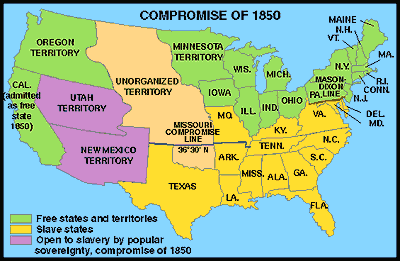Since the gold rush of 1849, California's population had grown rapidly. So now California (a territory at the time) petitioned to congress for them to be put as a free state. But since the Missouri Compromise had happened thirty years before, there needed to be another slave state to join the Union to keep both the free and slave states happy. Now comes a man named Henry Clay who so happened also created the Missouri Compromise thirty years before now stepped in to propose a compromise. The Compromise of 1850. For months Clay stated his opinion while his compromise was opposed by John C. Calhoun a Senator from South Carolina. But with the help of Stephen Douglas, they helped finally put the Compromise into effect. With this the North was happy because, California became the 16th free state, Texas lost its boundaries and was significantly smaller, and the biggest market for the slaves trade Washington D.C was shut down. Now on the other hand the South liked the compromise because Texas got 10 million dollars to pay its debts with Mexico and probably the most controversial part of the compromise was the Fugitive Slave Act which was that Northerners had to return runaway slaves to their masters or they would face consequences.
 |
Above was the effects of the Compromise of 1850
The Georgia Platform
|
The Georgia Platform was by no means an endorsement of the Compromise of 1850 and was resolution regarding the Compromise of 1850. Charles Jones Jenkins wrote a draft that was a "conditional acceptance" to the Compromise of 1850. It said that if they North was willing to enforce the Fugitive Slave Act and the North allow the expansion if slavery in territories and states that Georgia would stay with the Union. The Georgia Platform was credited for "saving the Union" but as we all know it only delayed the inevitable.
Charles Jones Jenkins
http://www.georgiaencyclopedia.org/nge/Article.jsp?id=h-798
http://www.ushistory.org/us/30d.asp
http://www.pbs.org/wgbh/aia/part4/4p2951.html


No comments:
Post a Comment